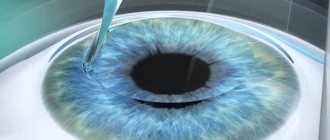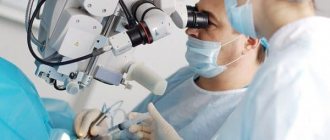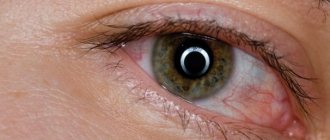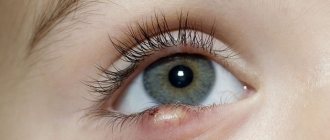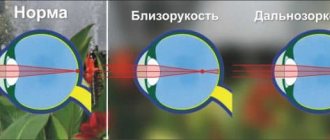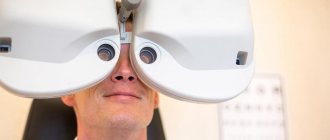With farsightedness, refractive error occurs, causing rays to be refracted incorrectly. That is, they are focused not on the retina, but behind it. This leads to blurred vision.
Often, a patient who is first diagnosed with hyperopia wonders whether farsightedness is a plus or a minus.
With farsightedness, visual acuity decreases, which leads to characteristic complaints: a burning sensation in the eyes, fatigue, and frequent headaches. This is accompanied by a decrease in quality of life, because the person has difficulty reading small text (including price tags), and he can no longer work with small objects.
Sometimes the expression that farsightedness is a plus can be misunderstood. In this case, the doctor only means that the degree of refractive error with farsightedness is indicated with a plus sign. She may be:
- Weak (up to + 3 diopters);
- Medium (3-6 diopters);
- High (more than 6 diopters).
Hypermetropia requires correction with glasses with positive lenses. Since the image is focused further than the retina, such lenses help move the focus point directly to the retinal plane. The curvature of the lens depends on the degree of hypermetropia.
Causes of farsightedness
Farsightedness is a pathology in which viewing nearby objects is problematic, but in the distance it is clearly visible. Normally, the image in the form of a stream of light particles hits the cornea, through the pupil - onto the lens, which is responsible for focusing, and then onto the retina. The center of the retina (macula) transmits the inverted image through the optic nerve to the superior colliculus, where the signals received from both eyes are decoded into a three-dimensional image. With farsightedness, focusing occurs not in the macula, but behind it. This is caused by two reasons.
- Congenital farsightedness (hyperopia) - the eyeball is shortened, which leads the beam beyond the macula. Occurs as normal in all newborns. As you grow older, the organ of vision acquires the required size. If the volume remains at an insufficient level, we are talking about pathology;
- Acquired farsightedness (presbyopia) - weakening of the accommodative muscles disrupts the process of changing the curvature of the lens, the ability to increase the radius of curvature. The disease occurs in adulthood, around the age of forty;
Presbyopia is more common - age-related changes affect everyone, both those who have 100% vision in youth and those who are nearsighted. Therefore, farsightedness is corrected with both positive and negative lenses, but this is always a positive increase in refraction.
Causes of farsightedness
The natural cause of farsightedness is insufficient development of the eyeball, as a result of which the focus of the image shifts to the area behind the retina. This explains the presence of temporary dysfunction in infants, which goes away independently as they develop.
In an adult, the disease develops as a result of the inability of the eye lens to properly change curvature, which becomes the cause of the so-called age-related farsightedness, in which the blurriness of the image of nearby objects increases over time.
The photo shows the image that a person suffering from farsightedness sees.
Farsightedness is often accompanied by aphakia
– a congenital or acquired condition in which the lens of the eye is missing. This can happen as a result of physical trauma, as well as surgical intervention in the treatment of certain diseases (for example, cancer), which require removal of the lens. With aphakia, a person’s vision decreases to almost 0.1, so for correction they use lenses with a maximum positive indicator or by implanting a lens.
Signs of farsightedness
The initial stage of development of farsightedness occurs unnoticed, so it is difficult to recognize it. However, there are several signs, the manifestation of which requires consultation with a specialist:
- Impaired twilight vision;
- Photophobia;
- lacrimation;
- Hyperemia of the eyeball;
- Headache;
- Increased fatigue when there is a load on the visual apparatus;
- Frequent eye inflammation;
- Blurred outlines of objects.
The disease can progress. There are three degrees of development:
- Weak - up to two units (diopters) - changes affect only near vision, clarity decreases, but it is still possible to see something;
- Medium - from two to five diopters - close distances are inaccessible without correction means, distant distances are still visible;
- High - more than five units - vision suffers at all levels - both far and near.
Is hidden farsightedness dangerous to health?
Young people may not notice symptoms of farsightedness because in most cases, mild hyperopia does not impair vision. A person sees well due to tension in the eye muscles, but without adequate help, prevention and correction, the existing pathology will progress, and then symptoms such as asthenopia, impaired binocular vision, increased fatigue, headaches will become apparent, strabismus or amblyopia (syndrome) may occur. lazy eye). The lack of adequate correction significantly reduces the quality of life of a person, for whom any visual stress will result in a deterioration in well-being and increased fatigue.
With farsightedness, the outflow of intraocular fluid, which is continuously produced by the ciliary crown, is hampered, which increases the risk of developing such an insidious disease as glaucoma, which also develops asymptomatically at first. The earlier hypermetropia is diagnosed, the higher the chances of successful treatment of the disease.
Farsightedness in children
In children, hypermetropia can be physiological (if vision returns to normal over time) and congenital (if vision does not normalize). In the latter case, it is important to promptly determine the pathology, because mild hypermetropia in both eyes can lead to complications over time.
Babies are born with a slight degree of farsightedness, but in children of 1 year, vision gradually normalizes. After the baby reaches the age of 1 year, correction of this pathology is required. Otherwise, advanced farsightedness can lead to amblyopia – the so-called “lazy eye” syndrome. When a baby tries to focus his gaze on an object, he strains his healthy eye, and relaxes the other one. As a result, the second eye may gradually fail, and the baby will subsequently require vision correction.
Another complication is convergent strabismus, which occurs as a result of impaired binocularity. Strabismus in children can occur not only due to hypertrophy and other abnormalities of the extraocular muscles, but also due to farsightedness. Often, such a pathology takes a long time to develop and is determined already when children go to school. But to prevent strabismus, preventive examinations of children are carried out at 1 year, 3 years and 6 years.
Therefore, in order to promptly suspect farsightedness, parents should pay attention to the following signs in children:
- Frequent eye redness and tearing.
- The child squints to see something close up.
- He blinks frequently while reading.
- Eye inflammation occurs periodically.
- The baby often rubs his eyes.
In addition, children who have vision problems often have other manifestations. It is difficult for them to concentrate on classes, they quickly become distracted and tired, and their attention decreases. Such children often refuse to read. If you have such signs, it is better to immediately visit an ophthalmologist and undergo the necessary tests.
As a rule, to correct vision, children are prescribed constant wearing of glasses. As the child gets older, the doctor suggests other treatment methods.
Prevention of childhood farsightedness
Scheduled visits to the doctor at least once a year. To prevent farsightedness, it is necessary to monitor the lighting when writing, reading, and the amount of visual load. Spend more time playing active games in the fresh air, get a balanced diet with an emphasis on vitamins and minerals. Do eye exercises regularly.
A video with Dr. Komarovsky will tell you how to determine whether children have problems with vision and even hearing:
Approach the issue of farsightedness in children with responsibility and enthusiasm, and everything will work out for you, be healthy!
Share your ways of dealing with this scourge in the comments with other subscribers. Don’t forget to bookmark this article so you can do eye exercises every day in a playful way with us! All the best! Tearfulness of the eyes, you will find the answer in the link.
Diagnosis of farsightedness
At the first signs of farsightedness, consultation with an ophthalmologist is necessary. Detection of farsightedness, minus or plus, occurs in stages:
- Visual test of distance vision according to the Golovin-Sivtsev table;
- Autorefractometry;
- Measuring intraocular pressure;
- Examination of the fundus using a mirror or ultrasound;
- Selection of reading glasses using special tests.
Farsightedness correction
Traditionally, farsightedness is corrected using glasses and contact lenses.
Spectacle correction
In the early stages of farsightedness, plus lenses are used. Many patients do not ask themselves whether farsightedness is a plus or minus, and engage in self-selection. Such independence is harmful to health and provokes progression. You must purchase glasses from specialized opticians with a doctor's prescription. For farsighted clients, there are three types.
Monofocal
Lens with one focal diopter. With a weak degree of farsightedness, these types of plus lenses begin to be used. When selected correctly, it provides clear vision in the reading area. It is recommended to install them in narrow frames so that the patient does not look through them into the distance, the so-called “lecturer frames”. Beginner presbyopes are recommended to use them without a coating or with an anti-reflex (anti-glare) coating, which ensures greater vision accuracy.
Bifocal
Lens with two diopters. A wide strip for distance with one diopter, a segment at the bottom for reading on the other. Easily distinguishable - the segment is separated by a clear line visible from the outside. Convenient because they replace two pairs of glasses. Recommended for moderate to high farsightedness. Applicable for myopia with the development of presbyopia - even with initial degrees, myopes have to wear second glasses. It is recommended to install in a large frame, at least three centimeters in height, to ensure sufficient visibility from both zones. Since these are glasses for constant wear, they can be uncoated, with an anti-reflex coating, or photochromic - darkening outdoors under the influence of ultraviolet radiation, brightening indoors. Pros: ability to see near and far, affordable price. Disadvantages - visual accuracy is ensured only at two distances, the middle distance falls out of view, discomfort due to a sharp change in diopters, the lower part of the eye visually appears larger than the upper.
Multifocal (progressive)
Lens with a smooth transition from distance to near. It has a fairly wide field for distance and a narrowing corridor of progression. Provides accurate vision at any distance. For medium and high degrees of farsightedness. Installation is recommended in a comfortable, not small frame - progressive glasses are worn constantly. It is possible to produce lenses without coatings, with anti-reflex coatings and photochromic ones. Pros: the ability to see at any distance, no visual division into zones, regulation of vision by moving the head, no sharp change in dioptres. Disadvantages - distortion on the periphery, narrow corridor for medium and close distances, manufacturing time - about three weeks, difficult adaptation - in some cases takes up to two months, high price - there are individual digital lenses in which the progression corridor is wider, adaptation is more comfortable, Distortion is practically unnoticeable, but the cost of such a product is high.
Is farsightedness correction necessary in children under 1 year of age?
Correction of farsightedness in children under 3 years of age is not carried out. At this age, it is dangerous to use glasses and contact lenses to improve vision. The same applies to the possibility of performing microsurgical operations on the eyes. Until the end of the period of active growth of the eye, surgical interventions on the visual organ are performed extremely rarely.
At older ages, glasses can be used to correct hypermetropia. In adolescence, correction with lenses is allowed. But laser surgery can only be prescribed to patients over 16 years of age.
Read about soft and hard contact lenses here.
To correct vision in one-year-old children with farsightedness, it is allowed to wear special glasses
Treatment methods
Treatment of mild hypermetropia must be carried out by a qualified attending physician. Based on diagnostic data, he will be able to develop a treatment regimen that will allow you to return your natural visual acuity. Most often, correction involves constant wearing of contact lenses with a positive diopter. Typically, a person with farsightedness is prescribed two pairs of glasses - one for near, the other for distance. In some cases, intraocular lenses are used - usually they are used when there are contraindications for surgery.
Keep in mind that the treatment of mild hypermetropia involves improving visual acuity. This is all a temporary measure - as soon as you stop following the recommendations of your doctor, everything will come back. To achieve significant therapeutic results, specialists send patients for massages and other physical treatments. Laser methods of vision correction show the greatest effectiveness.
How to get rid of farsightedness - methods of correction
Mild hypermetropia is practically invisible and not felt. Latent hypermetropia, which is diagnosed during an ophthalmological examination with artificially induced paralysis of accommodation, becomes overt with age, accompanied by decreased vision. Vision can be compensated by wearing glasses and contact lenses with positive diopters. This method of correction is effective for people who need to do work at close range during the day.
Types of glasses for farsightedness:
- for reading, for short-term work with small objects;
- for constant wear - glasses with bifocal lenses are recommended for people who have poor vision both at close and long distances;
- luxury glasses with progressive lenses - the optical areas of the lenses provide good vision not only near and far, but also at an average distance.
Using glasses and contact lenses is the most common way to correct farsightedness.
Unfortunately, it is not suitable for all patients, because there are many people who experience persistent discomfort when wearing contact lenses or glasses, which is expressed in double vision, distortions in the usual perception of space and other negative symptoms.
Treatment of farsightedness
Traditionally, treatment tactics involve conservative and surgical practice.
Conservative
- Use of corrective glasses or soft contact lenses;
- Gymnastic exercises for the visual apparatus using the Bates method;
- Training with the help of perforation training glasses;
- Massage of the eye muscles;
- The use of medicinal drops and dietary supplements to improve muscle nutrition;
- Physiotherapy (magnetic laser, water therapy, reflexology);
- Electrical stimulation of the eyes.
Surgical
- Laser correction - formation of a surface with multifocal properties on the cornea of the eye;
- Keratoplasty is the implantation of a piece of the cornea, which allows you to change the size of the eyeball;
- Lens replacement - transplantation of an artificial intraocular lens after removal of the affected lens;
- Hyperphakia - transplantation of an additional positive lens.
How to correct farsightedness
Modern advances in the field of ophthalmology make it possible to restore vision in case of farsightedness using several techniques. Several decades ago, a method of incisions that were applied to the cornea (radial keratotomy) was proposed. After healing of these incisions, the shape of the cornea changed, and therefore the optical power increased.
Nowadays, this technique is not justified due to the high risk of complications. In addition, the result of the operation is unpredictable, and it is not possible to operate on both holes at once.
The most popular and effective technique nowadays is laser correction for refractive error, which can be performed on an outpatient basis. During manipulation, a laser beam is directed into a specific area, which changes the shape of the cornea. In this case, damage to deeper layers does not occur. In cases of severe farsightedness, phakic lenses are implanted or the lens is replaced with an artificial one.
All of these surgical interventions are quite safe and very effective. Despite this, there remains approximately 1% of patients who experience various types of complications during or after surgery. Because of this, many people prefer spectacle correction. Alternative medicine specialists believe that this method further reduces visual acuity.
Complications
Complications are quite numerous:
- Further progression of farsightedness, up to complete blindness;
- Increased level of eye fatigue;
- Inflammatory processes of the organ of vision - conjunctivitis, blepharitis, barley;
- Glaucoma - increased intraocular pressure;
- Cataract - clouding of the lens;
- Strabismus - most often develops in children;
- Amblyopia, the so-called “lazy eye,” is a pathology in which the joint work of one eye and the brain is disrupted, as a result of which the load falls on a healthy organ.
When age-related changes occur, you quickly find out whether farsightedness is a minus or a plus. Selecting a plus correction helps to compensate for the insufficient functionality of the lens. To avoid complications and prolong the healthy life of the visual organ, it is necessary to follow preventive recommendations and visit a specialist in a timely manner.
Farsightedness (hyperopia) is a vision defect in which the eye sees objects at a distance better, but objects near are blurred.
The disease is associated with improper refraction of light by the eye.
When the eyeball is too “flattened”, which is typical for farsightedness, light rays are focused not on the retina, but behind it. This results in a blurry image.
How does a person see if his vision is minus 2?
The inability to examine objects located at a long distance becomes an unpleasant “surprise” for many people; it seems that, without any prerequisites, the pathology developed independently.
Moreover, people do not notice the symptoms of an impending problem until the last moment, and therefore a sharp decrease in the clarity of vision is very frightening. A person, as a rule, does not experience discomfort with a low degree of myopia, and does not require glasses. He sees objects well at a distance of up to one and a half meters, and is able to distinguish in general terms objects located further away. In medical terms, this disease is called myopia. Let's figure out how vision minus 2 is seen by a person, consider the prerequisites for the occurrence of the disease, the signs accompanying the pathology and methods of combating it.
Modern diagnostic methods
Farsightedness is a disease that requires mandatory extensive diagnostics. If this disease is not identified in a timely manner and the patient is not given proper treatment, he may experience serious complications.
The doctor is obliged to send the patient for a full diagnosis, with the help of which this pathology can actually be identified.
For this purpose the following studies are carried out:
- Visometry is the most common study that is mandatory when diagnosing hypermetropia. It allows you to determine how a person sees at a distance;
- Skiascopy is a procedure that allows you to determine the refraction of the eye. The doctor determines the condition of the fundus. The study is carried out in a dark room using a beam of light;
- Computer refractometry is a computer study that allows you to determine the exact parameters of refraction;
- Ultrasound - allows you to determine the condition of the tissues in the eye sockets. Also aimed at diagnosing the entire organ of vision;
- MRI is a procedure that allows you to evaluate the structure of the eye and optic nerves;
- Fluorescein angiography – determines the condition of the vessels and capillaries of the retina;
- Perimetry is a procedure during which a specialist determines the visual field. With its help, it is possible to assess the condition of the retina and optic nerves;
- Ophthalmoscopy is a research method in which a specialist evaluates the eye vessels and retina;
- Biomicroscopy is a diagnostic method that is performed using a slit lamp. It allows you to identify various changes in the vascular tissue, retina and optic nerve;
- Tonometry is a study that makes it possible to determine intraocular pressure. It allows you to identify glaucoma at the initial stages;
- Biometric eye examination is a study that allows you to identify strabismus in the initial stages.
Lenses for farsightedness “plus” or “minus”
Farsightedness is corrected by convex glasses: they are thicker in the center than at the edges. Convex lenses collect light rays and bring the image closer to the retina, focusing it clearly.
Glasses with converging lenses are “plus”. Their refractive power is measured in diopters with a plus sign.
The parameters of spectacle lenses are determined by a specialist after a thorough examination of the patient’s vision, the curvature of his eyeball and the thickness of the lens.
Eye drops to improve vision for farsightedness
Now there is a wide list of means, the purpose of which is to improve vision and prevent disease
But special attention should be paid to the following drops:
- Taufon. This remedy is usually used for age-related farsightedness. In addition, the drug is prescribed to combat corneal injuries, cataracts, and retinal diseases. The active component of the drug accelerates the restoration of deformed walls of the eyeball. It helps stabilize pressure in the visual organ and improves metabolism in cells. Often patients using Taufon admit that such drops best restore vision. In addition, the product relieves discomfort, itching, and the feeling of sand in the eyes. It should be used four times a day. The course of treatment will last from a month to a month and a half.
- Quinax. The active drug helps to dissolve protein deposits that accumulate in the lens. Eventually, the surface of the eyes becomes clear in color, which helps improve vision. Such drops with vitamins have a large number of positive reviews from patients. Quinax is used four times a day, five drops.
Originally posted 2018-01-31 10:16:19.
Glasses for presbyopia
With the development of age-related farsightedness, when the eye cannot correctly focus vision on a nearby small object, glasses “for reading” are prescribed. In many cases this is enough.
The power of spectacle lenses is measured in positive diopters and depends on the thickness of the lens, the age of the patient and the distance between the object being manipulated and the eye. Typically this distance is 30 cm.
However, with such glasses, the image of distant objects seems fuzzy and blurry. If a farsighted patient also needs distance glasses, bifocal glasses are prescribed.
Bifocal glasses have two zones at the same time: “for near” and “for distance”. Essentially, these are two pairs of glasses, plus and minus, with two prescriptions and put together.
Bifocal glasses have many modifications. The area of the lens used to work the eyes at close range is located slightly lower or higher in relation to the frame. The parameters are determined by the state of vision and occupation.
For comfortable reading, a distance from the book to the eyes is required - 30-40 cm. A carpenter, accustomed to doing his work at arm's length, needs clear vision at a distance of 60 cm. A musician playing in an orchestra reads sheet music at a distance of 70 cm, and sometimes looks at the conductor. It needs a larger segment for near vision and a smaller segment at the top of the glass for distance vision.
In addition, there are also trifocal glasses. They combine three recipes.
In bifocal glasses, through the upper part of the lens it is convenient to look into the distance at a distance of 1.5 m; through the reading segment, close objects are better visible. The gap from 0.5 m to 1.5 m remains a difficult to distinguish zone. If you need to clearly distinguish everything at this distance, they resort to a trifocal spectacle lens, which provides clarity for “intermediate” vision.
To ensure a smooth transition from one zone to another, they began to make “progressively complementary” spectacle lenses. They are slightly more expensive than regular bi- and trifocal ones. Still, some distortion may be felt at the junction of the segments. Patients adapt to trifocal glasses in 5-6 days. Cosmetically, glasses with progressive lenses look more aesthetically pleasing.
Degrees of the disease
There are 3 degrees of development of farsightedness:
- Weak. Up to +2.5 diopters. There are some difficulties when reading small print at a distance of 30 cm. Long-term work causes eye fatigue, expressed in headaches and pain in the eyes.
- Average. From +2.5 to +5 diopters. Distance vision is normal, but the contours of nearby objects are blurred.
- High. From +5 or more diopters. The contours of both distant and close objects are blurred.
Spectacle correction is offered to those suffering from moderate to severe hypermetropia. Glasses are selected with glasses of the highest degree of refraction that the patient can tolerate.
Treatment Options
If a child’s farsightedness progresses, there is no need to panic under any circumstances. Modern medicine has achieved such development that many problems in the functioning of the visual apparatus can be completely eliminated without harm to the future health of the baby.
How to restore vision with farsightedness? Treatment methods most often used in this case:
- Prescribing glasses that can not only correct hypermetropia, but also eliminate strabismus.
- Prescribing eye gymnastics, which helps improve muscle function and reduce the development of the problem.
- Hardware therapy is used, with the help of which in just 5-7 sessions it is possible to significantly reduce the degree of development of farsightedness.
At the age of 2-3 years, the child is prescribed glasses with a difference of 2 diopters. So, if a child has a deviation of 4 diopters, glasses of 2 are suitable for him.
An effective remedy for combating pain and swelling is the instructions for Diclof eye drops.
It is important not to create problems from the necessary vision correction
If deviations from the above standards do not exceed 2.5 diopters, treatment is usually not carried out. It is believed that this problem will disappear on its own with age. However, doctors recommend being examined as often as possible in order to notice deviations in time.
Dr. Komarovsky also speaks about this. The famous doctor notes that childhood farsightedness and astigmatism are extremely common problems, and in no case should they be ignored. It is recommended to regularly engage in eye exercises with children, wear special glasses with blinders for astigmatism, and have their vision checked by a doctor.
Dr. Komarovsky recommends using glasses until the doctor notes progress in treatment.
Breastfeeding is the basis for the formation of healthy organs (including visual ones)
Possible methods of treating age-related farsightedness are described in the article.
Treatment of eye hypermetropia with folk remedies
lotions made from aloe leaf juice will help against hypermetropia
In order to quickly cure hypermetropia , you can use traditional medicine recipes in treatment. For example, this infusion is very useful: 1 kg. Rinse brown rose hips and pour 3 liters. water - cook until softened. Rub the fruits through a sieve and add 2 cups of honey. Cook over low heat for 5 minutes. Pour into sterile bottles, seal and store in a cool, dark place. Take 100 ml. 4 times a day before meals.
To treat conjunctivitis , which often occurs with hypermetropia, you can use lotions with dill juice, which are applied to the eyes for 20 minutes.
Another method is the use of grated potatoes, which are applied to the eyeballs, and a cloth soaked in hot water is applied to the neck and back of the head.
When barley occurs, lotions made from aloe leaves help. Wash 1 leaf of a three-year-old plant and place in the refrigerator for 2 hours. Squeeze the juice, dilute with warm boiled water in a ratio of 1 to 10.
A warm compress of chamomile infusion is also applied to the eyes . In this case, it is necessary to apply a compress to both the patient and the uninfected eye in order to prevent infection of the healthy eye.
Useful video
Poor vision significantly worsens the quality of life and makes it impossible to see the world as it is.
Not to mention the progression of pathologies and complete blindness.
MNTK "Eye Microsurgery" published an article on non-surgical restoration of vision up to 90%, this became possible thanks to.
- About our center
- Clinic specialists
- Our guarantees
- Quality Policy
- News
- Articles
- Question answer
- Reviews
- Video reviews
Our advantages
Compliance with international standards ISO 9001:2015.
Today this is the most effective vision correction operation.
Lifetime guarantee on the quality of operations performed.
New technologies and techniques are being introduced that bring consistently successful results.
Promotions and Discounts
*Discounts provided are not cumulative
Farsightedness (hyperopia) is a refractive error in which light rays are refracted in such a way that they are focused behind the retina. This prevents you from seeing a clear image.
When a person is first diagnosed with farsightedness, he asks the question: is farsightedness a plus or a minus?
Like any refractive error, hypermetropia reduces visual acuity and causes a number of asthenopic complaints: a burning sensation in the eyes, fatigue, headaches. This means an inevitable decline in quality of life. It is difficult for a person to read small text on product packaging, it is impossible to work with small objects, embroider, read, etc. For farsighted people, all of the above activities become a serious problem.
What do experts mean when they say that farsightedness is a plus? We are talking about the degree of farsightedness:
- weak – up to +3 D,
- average – from +3 to +6 D,
- high – from +6 D.
Hypermetropia is a refractive error that requires correction with “plus” lenses. In a farsighted person, the image is focused behind the retina. “Plus lenses” change the refraction of rays so that they are focused clearly on the retina. The curvature of the lens is determined by the degree of hypermetropia.
How farsightedness occurs
- 3.1 Optics
This disease is a refractive error, considered one of the most common. Farsightedness is formed in the following way. In the human eye, two refractive media exist in parallel. One of them is the cornea, the second is the lens. It is thanks to them that a person receives an image near and far.
Farsightedness
Rays from an object follow the visual path, are refracted by one or another medium and fall on the retina. There they are focused and transported to the brain along neural pathways, where they are processed into visual information that is understandable to humans.
Vision with farsightedness
Everything is simple if both refractive media work properly. But if the lens does not cope with its functions due to deformation or other, or if the cornea does not have enough convexity, the path of the beam changes, and the image shifts focus from the retina to the space behind it. As a result, the image remains blurry because the signal reaches the brain cells. The brain cannot process it with 100% clarity. A person sees a blurry object that is nearby. This applies to a book or monitor, or any object that is located closer than arm's length. Therefore, to increase clarity, you have to move the object further and further. This is the first sign of hypermetropia or farsightedness - a disease of the eyelid.
How to treat farsightedness
By the way. With a strong degree of farsightedness, a person sees poorly not only close, but also far away objects. Therefore, many patients are confused, unable to understand what hypermetropia is - “minus” or “plus”. The disease is corrected with “plus” optics.
Farsightedness is a “plus”, and it comes in three degrees.
- Weak degree – below +3 D.
- Average degree – from +3 D to +6 D.
- High degree above +6 D.
With farsightedness, symptoms manifest themselves differently depending on the degree of the disease.
Correction of hypermetropia is carried out with “plus” optical devices. Since in this case the focus of the image is shifted behind the retina, these optics bring it closer, returning it to the body of the retina. The curvature of the corrective lens depends on the degree of the disease.
Farsightedness, which occurs as a result of age-related changes, is of a slightly different nature. It is officially called presbyopia, but in everyday life it is called age-related farsightedness, and its cause is a weakening of the accommodative properties of the lens.
By the way. Presbyopia is a separate disease that a person can have along with hypermetropia or myopia (so-called myopia).
What is presbyopia
Symptoms
Farsightedness When farsightedness occurs, the following symptoms may occur:
- The first signs appear in childhood. The child begins to study worse, gets tired quickly, and sleep is disturbed.
- When working with objects at close range, a person may feel overstrain, eye fatigue, headache, and “sand” in the eyes.
- Convergent strabismus may occur. It appears constantly or from time to time.
- Conjunctivitis and blepharitis become chronic.
The best eye drops for tired and red eyes can be found here.
These symptoms should not be ignored. With a weak degree of hypermetropia, they are the ones who will indicate the presence of problems. A timely visit to an ophthalmologist will help diagnose farsightedness and begin treatment.
Prevention of farsightedness in adults
It is impossible to stop age-related farsightedness - this is an inevitable process of aging of the body. By the age of sixty, a person’s eyes, unfortunately, lose their ability to accommodate. The muscles of the eye lose elasticity when focusing at close range and cannot contract to the required size. But the progression of farsightedness in adults of working age can be stopped. Prevention and treatment of farsightedness:
- strict work and rest schedule, reducing the load on the optic nerve and muscles, changing lifestyle;
- gymnastics for the eyes: squeezing and unclenching the eyelids for better blood supply, circular movements of the eyes, etc., as well as a light massage of the eyes and cervical-collar area;
- hardware treatment: ultrasound, vacuum massage, restoration of blood flow in the vessels, acceleration of the circulation of intraocular fluid using an infrared laser, electrical neurostimulation - training of the eye muscles, relieving spasms (with farsightedness, the eye muscles are constantly tense);
- fortification, enriching the diet with healthy foods, such as spinach, blueberries, carrots.
Experts also recommend using eye drops as part of a set of preventive measures. Drugs such as Taufon improve metabolic processes, relieve fatigue, normalize intraocular pressure, stop degenerative processes, and protect the retina from the negative effects of environmental factors.
Presbyopia, or when the arms are not long enough
Farsightedness, which is associated with age-related changes in the accommodative apparatus of the lens, is called presbyopia. Another name for it is “short arm disease”; This humorous definition is due to the fact that the presbyope needs to move the text a significant distance from the eyes in order to read it.
As the accommodative capabilities of the lens weaken, this becomes insufficient, and the person notices that reading the small print on the medicine package, in a book, or on the phone has become a problem.
Presbyopia can be combined with myopia or farsightedness. The ophthalmologist must take this into account when selecting glasses or contact lenses.
Treatment of hypermetropia
Treatment of hypermetropia is aimed at vision correction
For a pathology called hypermetropia , treatment is aimed at strengthening the refractive apparatus, which should lead to the focusing of light rays on the retina.
Treatment of eye hypermetropia can be conservative and surgical
Conservative methods of treating hypermetropia are correction using glass lenses (spectacle glasses) and contact lenses. Each of these methods has some disadvantages. For example, limited lateral vision when using glasses, the possibility of injury if the glasses are damaged, frequent fogging and contamination of the glasses. When using contact lenses, allergic reactions and intolerance by some people to the presence of a foreign body in the eye are possible.
Moderate hypermetropia in children does not require surgical correction, however, high hypermetropia in children, accompanied by strabismus, requires complete th corrections.
Surgical methods for treating hypermetropia : LASIK, lens replacement, laser thermokeratoplasty, positive lens implantation. One of these methods called “LASIK” or vision correction using an excimer laser is an operation that allows the patient to quickly regain vision and forget about the problem once and for all yes.
The method of treating eye hypermetropia depends on the age of the patient , the presence of other diseases, and the type of his activity. For example, if the patient has autoimmune diseases, is pregnant, or is breastfeeding, laser vision correction is contraindicated.
